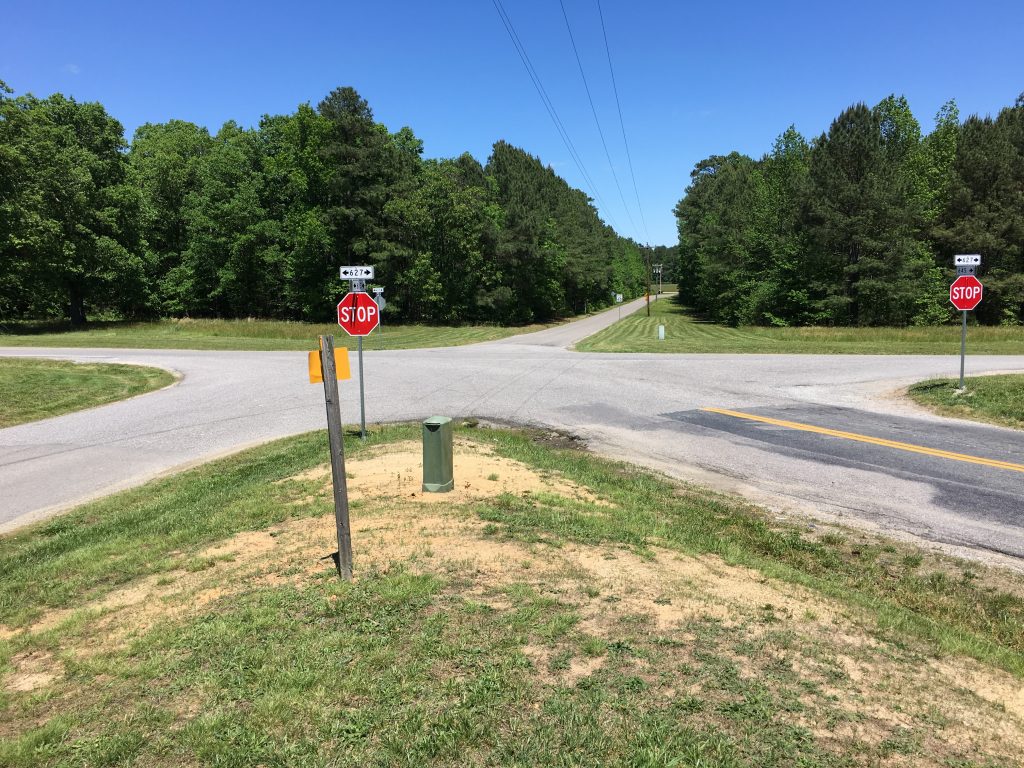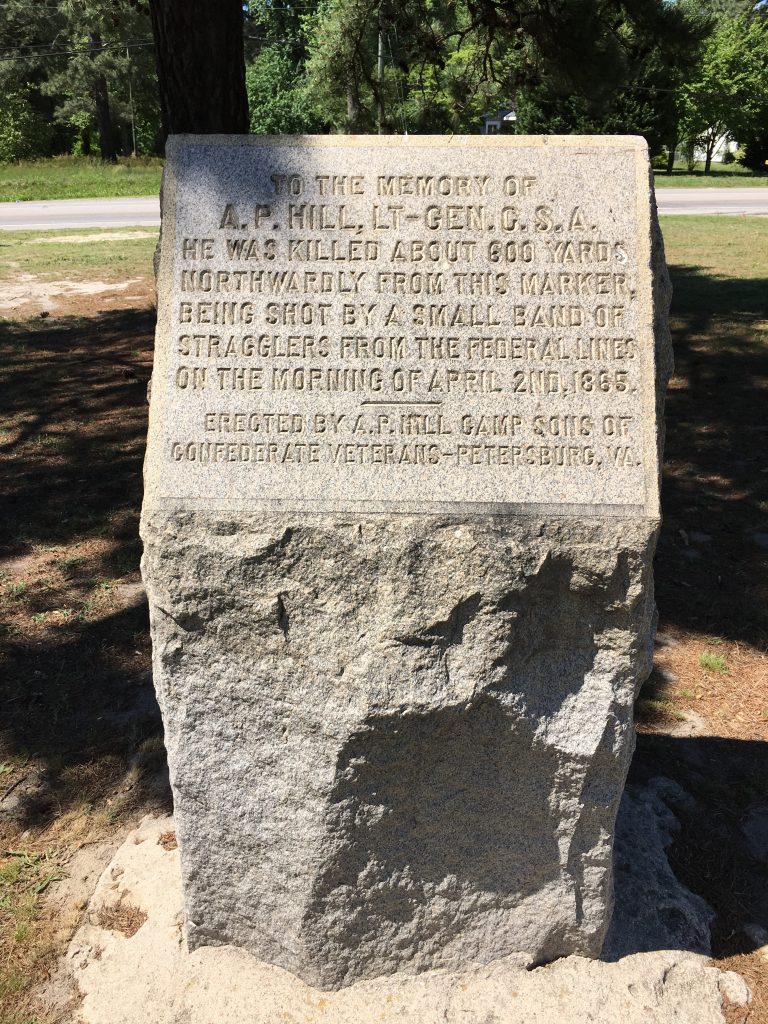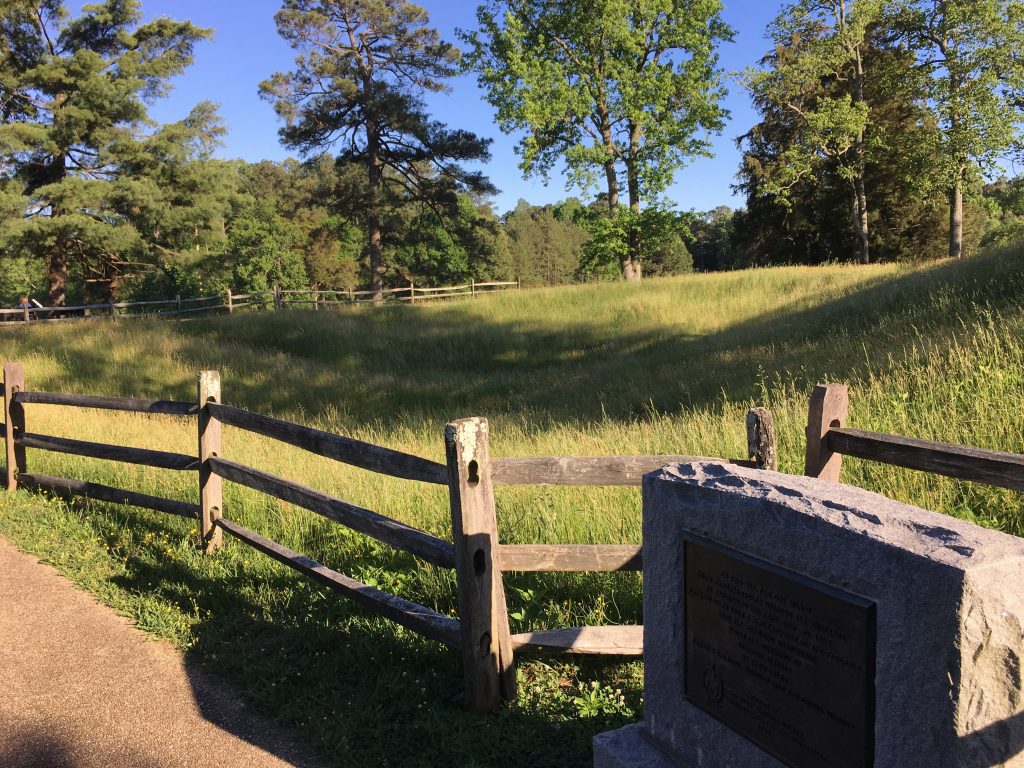Battlefield Visits: Raleigh, NC to Petersburg, VA
I’ve written before about a business trip I took to Raleigh, NC back in 2017. What I didn’t include in that post is the stops that I made on the way home to Maryland. I made the most of that travel day by visiting more than a dozen Civil War sites along the way from Raleigh to Petersburg. I packed a lot of adventure in to that day.
Bennett Place
I left my hotel and headed over to the site of the largest Confederate surrender of the war – and the first that I’d ever visited. I arrived at around 10am. The retired lady working at the front desk was very personable and knowledgeable – we hit it off immediately. She showed my around the visitors center, started their orientation movie for me, and then gave me a tour of the grounds. It’s a pretty nicely-kept place. The house itself, while not the original (it burned in 1921) is an exact duplicate that was moved from a farm 4 miles away. I’m told that it’s a good example of a 19th century middle class southern homestead. Overall, it was a very cool experience.
Battle of Dinwiddie Court House – Civil War Battlefield #42
After a couple hours in the car, I was ready to start the Petersburg area tour. The first stop that I made on the trip north was at this small battlefield that was basically just a precursor to the Battle of Five Forks. There are a few monuments and markers in front of the titular court house, but not much else.
Battle of Five Forks – Civil War Battlefield #43
This was a battlefield that I had been anticipating visiting for quite some time. Not only is this the place where Maj. General George Pickett’s Confederate division collapsed – forcing the rebels to abandon Petersburg – but Brig. General Joshua L. Chamberlain played a major role in the breakthrough as well.

There is a satellite visitors center for Petersburg National Battlefield here, but it is quite small. The field itself is also small and frankly feels kind of barren. There are a couple monuments at the intersection, and a few waysides there and at the Confederate left flank to tell the story of the attack.
Battle of White Oak Road – Civil War Battlefield #44
Like so many of these “smaller” battlefields around Petersburg, the Battle of White Oak Road is one where the Civil War Trust has done a lot of the work. There are a few waysides, and a nice trail that leads you along the battle line where earthworks are visible.
Battle of Boydton Plank Road – Civil War Battlefield #45
Taking White Oak Road east, I arrived at the intersection with the old Boydton Plank Road – now modern US-1. This was the center of the fighting at the Battle of Boydton Plank Road. There is a roadside marker near the intersection, but I didn’t find much else.
Battle of Lewis’ Farm – Civil War Battlefield #46
Officially, this action is referred to as the Battle of Lewis’ Farm, but the roadside marker here calls it the “Quaker Road Engagement”. A lot of Civil War battles have at least two names, and it seems like they can get especially confusing around Petersburg. The field on the east side of the road seems to be well-preserved farmland, but there is 20th century housing on the west side. Brig. General Chamberlain received his final wound of the war here.
Third Battle of Petersburg – Civil War Battlefield #47
The final breakthrough of the Confederate line at Petersburg, the Third Battle of Petersburg was a full-blown disaster for the Confederates. Aside from the fact that the loss forced the abandonment of their entire Petersburg line, it also claimed the life of one of their senior corps commanders: Lt. General A.P. Hill.

Battle of Peebles’ Farm – Civil War Battlefield #48
The Civil War Trust has laid out an interpretive trail here at the Battle of Peebles’ Farm that leads up toward the Pamplin Historical Park property. I didn’t walk the full trail (nor visit Pamplin) on this trip, but I feel like both would be worth doing. There are a few waysides here to help explain the fighting.

Battle of Hatcher’s Run – Civil War Battlefield #49
Several hundred acres of the field at the Battle of Hatcher’s Run have been saved over the years by the Civil War Trust. They have a small parking lot and some wayside markers that provide a jumping-off point for a trail.
Battle of Globe Tavern – Civil War Battlefield #50
Part of the fight for the Weldon Railroad, there are some good waysides here at the Battle of Globe Tavern. Also, Fort Wadsworth was quite large, and pretty intact. This site is part of the regular tour route for Petersburg National Battlefield, so it may see slightly more visitation than some of the other sites I visited.
First Battle of Petersburg – Civil War Battlefield #51
Maj. General Benjamin Butler’s attempt to take Petersburg ended rather quickly in the summer of 1864. It would take a prolonged siege – and far more troops than Butler had on hand – to get the job done.
Battle of Jerusalem Plank Road – Civil War Battlefield #52
The site of the Battle of Jerusalem Plank Road is on the eastern end of Flank Road. Fort Davis is intact here as a city park, and there is at least one wayside.
Petersburg National Battlefield: Eastern Front Section
My next stop was the really awesome Petersburg National Battlefield Visitors Center. It’s a really nice (if not a little dated) facility, with a nice array of artillery pieces out front. Highlights were a Wiard gun, a Whitworth, and a 30-Pounder Parrott. Inside the museum, there is lovely Revere Copper Co. Napoleon on display.

The “Battery 5” area behind the visitors center was also quite cool – most especially the site of the “Dictator” siege mortar that rests on a trail a short distance to the north.
After picking up a tour brochure, I started on the auto tour route, which goes along a one-way road headed south. Stop #3 – Confederate Battery #9 – was particularly interesting in the way that the park has it preserved and interpreted.
Battle of Fort Stedman – Civil War Battlefield #53
Within the Eastern Front section of Petersburg National Battlefield, the Battle of Fort Stedman is Stop 5 on the official auto tour. The fort itself is fairly well-preserved, and there is a trail over to where the Confederate position was. Only a few hundred yards separated the lines at this point. While Lee’s attack against this position met with initial success, the Confederates were forced back before noon. It would be the last purely offensive attack that Lee’s Army of Northern Virginia every made.
Second Battle of Petersburg – Civil War Battlefield #54
Lt. General Ulysses S. Grant had beaten Lee and the Army of Northern Virginia in the race to Petersburg, but there was still a small Confederate defense force that had turned back Butler’s attack about a week earlier. The Union assaults didn’t go off well, and the fortifications the rebels had built along the Dimmock line were substantial, so when Lee’s reinforcements arrived, the fight became futile. The Union failure to break the line here brought on the Siege of Petersburg.
Battle of The Crater – Civil War Battlefield #55
At the southern end of the Eastern Front auto tour route is the highlight of Petersburg, in my opinion: The Battle of The Crater.

This was a very cool, bucket-list kind of experience. What is left of the crater today is much smaller than I had imagined. Once the battle was over, the area returned to being used as farmland, and over the years, the once-massive hole in the earth had been gradually filled in. The entrance to the mine has been re-created, and there are some cool waysides that explain the event for visitors. The biggest surprise to me was just how short the mine tunnel was. The Union and Confederate lines were VERY close to each other in this sector.
Battle of Yellow Tavern – Civil War Battlefield #56
My last stop as I headed home was north of Richmond. The Battle of Yellow Tavern is most famous as the place where the Confederate cavalry lost its most famous commander: James Ewell Brown Stuart.

Today, the battlefield has been consumed by the modern US-1 / I-95 corridor. The original Yellow Tavern has been replaced by gas stations, restaurants, and some neighborhoods. Within one of those residential areas, Civil War nerds can find a monument marking the spot where J.E.B. Stuart was mortally wounded. He was taken to Richmond, died the next day, and was buried in Hollywood Cemetery.